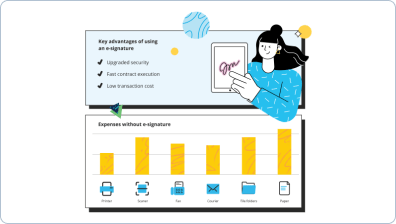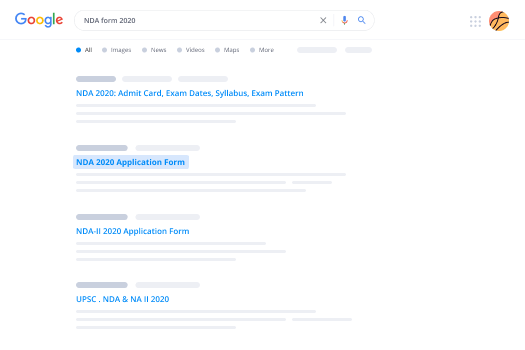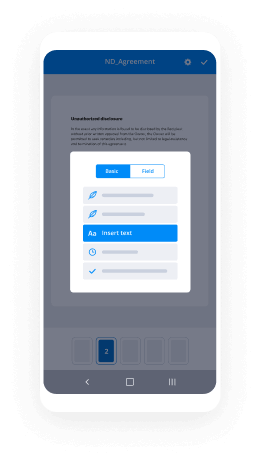Sign Affidavit of Death
- Quick to start
- Easy-to-use
- 24/7 support
Simplified document journeys for small teams and individuals




We spread the word about digital transformation
Why choose airSlate SignNow
-
Free 7-day trial. Choose the plan you need and try it risk-free.
-
Honest pricing for full-featured plans. airSlate SignNow offers subscription plans with no overages or hidden fees at renewal.
-
Enterprise-grade security. airSlate SignNow helps you comply with global security standards.







Excellent form management with airSlate SignNow
Gain access to a robust form collection
Generate reusable templates
Collect signatures via links
Keep paperwork safe
Enhance collaboration
eSign via API integrations
Quick-start guide on how to build, fill in, and sign affidavit death
Think of all the paper that you waste to print affidavit death document, not counting the countless other documents that are dozens of pages long that your organization uses weekly. That's a lot of wasted paper. It directly correlates to wasted natural resources and, of course, as well as budget. With airSlate SignNow eSignature, you can go paperless, reducing waste and raising efficiency.
Follow the steps below to edit and sign affidavit death form quickly:
- Open your web browser and go to signnow.com.
- Sign up for a free trial or log in utilizing your electronic mail or Google/Facebook credentials.
- Click on User Avatar -> My Account at the top-right area of the webpage.
- Customize your User Profile by adding personal information and changing configurations.
- Create and manage your Default Signature(s).
- Return to the dashboard webpage.
- Hover over the Upload and Create button and choose the appropriate option.
- Click on the Prepare and Send option next to the document's title.
- Enter the email address and name of all signers in the pop-up window that opens.
- Make use of the Start adding fields option to proceed to modify file and self sign them.
- Click on SAVE AND INVITE when you're done.
- Continue to customize your eSignature workflow employing advanced features.
It can't get any easier to sign a affidavit death pdf than that. If creating, editing, signing and tracking multiple documents and forms sounds like an administrative burden for your company, give powerful eSignature by airSlate SignNow a try.
How it works
Rate affidavit death form
What is the affidavit death
An affidavit of death is a legal document used to confirm the passing of an individual. It serves as a sworn statement that provides essential details about the deceased, including their full name, date of birth, date of death, and any relevant identification information. This document is often required in various legal and administrative processes, such as settling estates, transferring property, or claiming life insurance benefits. By utilizing airSlate SignNow, users can easily create, fill out, and eSign an affidavit of death, ensuring the document is both legally binding and accessible for all parties involved.
Steps to complete the affidavit death
Completing an affidavit of death electronically involves several straightforward steps. First, access the affidavit death template on airSlate SignNow. Users can fill in the required fields with accurate information about the deceased. After completing the form, it is essential to review the details for accuracy. Once verified, users can initiate the eSignature process by sending the document to the necessary parties for their signatures. airSlate SignNow allows users to track the status of the document and receive notifications when it has been signed, ensuring a smooth workflow.
Legal use of the affidavit death
The affidavit of death is legally recognized and serves various purposes. It is commonly used in probate proceedings to validate the death of an individual, which is crucial for settling estates. Additionally, financial institutions may require this document to release funds or assets held in the deceased's name. The affidavit can also be necessary for transferring ownership of property or vehicles. By utilizing airSlate SignNow, users can ensure that their affidavit of death meets legal standards and is properly executed, facilitating compliance with relevant laws.
Sending & Signing Methods (Web / Mobile / App)
airSlate SignNow offers flexible options for sending and signing an affidavit of death. Users can access the platform via web browsers, mobile devices, or the airSlate SignNow app. To send the document, users simply upload the completed affidavit, enter the email addresses of the required signers, and customize the signing order if necessary. Recipients can easily eSign the document using any device, making the process efficient and convenient. This versatility ensures that users can manage their documents from anywhere, streamlining the workflow for all involved.
Security & Compliance Guidelines
When handling sensitive documents like an affidavit of death, security and compliance are paramount. airSlate SignNow employs advanced encryption methods to protect user data during transmission and storage. The platform complies with industry standards and regulations, ensuring that all electronic signatures are legally binding. Users can also set access controls and permissions to safeguard their documents further. By following these security guidelines, users can confidently manage their affidavit of death and other important documents, knowing that their information is secure.
Examples of using the affidavit death
An affidavit of death can be utilized in various scenarios. For instance, it may be required when a beneficiary needs to claim life insurance benefits after the policyholder's passing. Additionally, it is often necessary in estate planning, where the executor must prove the death to initiate probate proceedings. Another common use is for transferring real estate ownership, where the affidavit serves as proof that the previous owner has passed away. With airSlate SignNow, users can easily create and manage these documents, ensuring they are prepared for any legal requirements that may arise.
-
Best ROI. Our customers achieve an average 7x ROI within the first six months.
-
Scales with your use cases. From SMBs to mid-market, airSlate SignNow delivers results for businesses of all sizes.
-
Intuitive UI and API. Sign and send documents from your apps in minutes.
FAQs affidavit death pdf
-
What is an affidavit death and why is it important?
An affidavit death is a legal document that verifies the death of an individual, often required for settling estates or accessing benefits. It serves as proof for various legal processes, making it essential for executors and beneficiaries. Understanding its importance can help streamline the administrative tasks following a death.
-
How can airSlate SignNow assist with creating an affidavit death?
airSlate SignNow provides an easy-to-use platform for creating and signing an affidavit death electronically. With customizable templates, users can quickly fill in necessary details and ensure compliance with legal standards. This simplifies the process, saving time and reducing the risk of errors.
-
What are the pricing options for using airSlate SignNow for affidavit death documents?
airSlate SignNow offers flexible pricing plans that cater to different needs, including options for individuals and businesses. Users can choose a plan that fits their budget while accessing features necessary for managing affidavit death documents. A free trial is also available to explore the platform's capabilities.
-
Is it secure to use airSlate SignNow for affidavit death documents?
Yes, airSlate SignNow prioritizes security, employing advanced encryption and compliance measures to protect sensitive information. When handling affidavit death documents, users can trust that their data is secure and confidential. This commitment to security ensures peace of mind during the signing process.
-
Can I integrate airSlate SignNow with other applications for affidavit death management?
Absolutely! airSlate SignNow offers integrations with various applications, enhancing the management of affidavit death documents. Users can connect with tools like Google Drive, Dropbox, and CRM systems to streamline workflows and improve efficiency. This flexibility allows for a more cohesive document management experience.
-
What features does airSlate SignNow offer for managing affidavit death documents?
airSlate SignNow includes features such as customizable templates, electronic signatures, and document tracking, all tailored for affidavit death management. These tools simplify the creation, signing, and storage of important legal documents. Users can also collaborate in real-time, ensuring all parties are informed and engaged.
-
How does airSlate SignNow improve the efficiency of handling affidavit death documents?
By utilizing airSlate SignNow, users can signNowly reduce the time spent on affidavit death documents through automation and streamlined processes. The platform allows for quick document creation, easy sharing, and instant signing, which accelerates the overall workflow. This efficiency is crucial during sensitive times when timely actions are necessary.
Affidavit death
Trusted eSignature solution - affidavit death template
Related searches to affidavit of death
Join over 28 million airSlate SignNow users
Get more for sign affidavit
- ESignature Licitness for Financial Services in India
- Enhance eSignature Legitimacy for Financial Services in ...
- ESignature Licitness for Government in Australia with ...
- Unlock eSignature Licitness for Government in Mexico ...
- ESignature Licitness for Government in United States - ...
- Unlock eSignature Licitness for Government in European ...
- ESignature Licitness for Government in Canada
- Unlocking eSignature Licitness for Government in India
The ins and outs of eSignature




















































